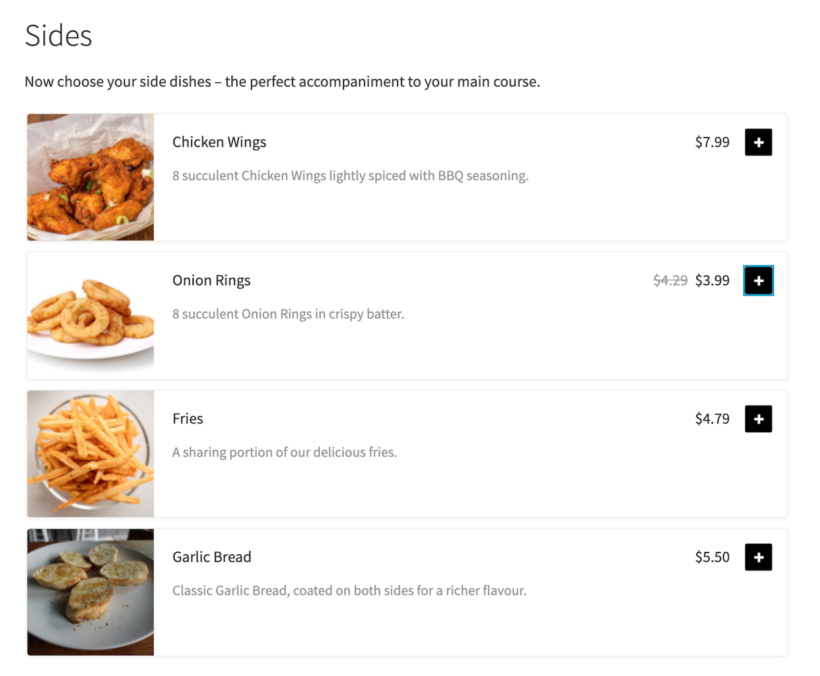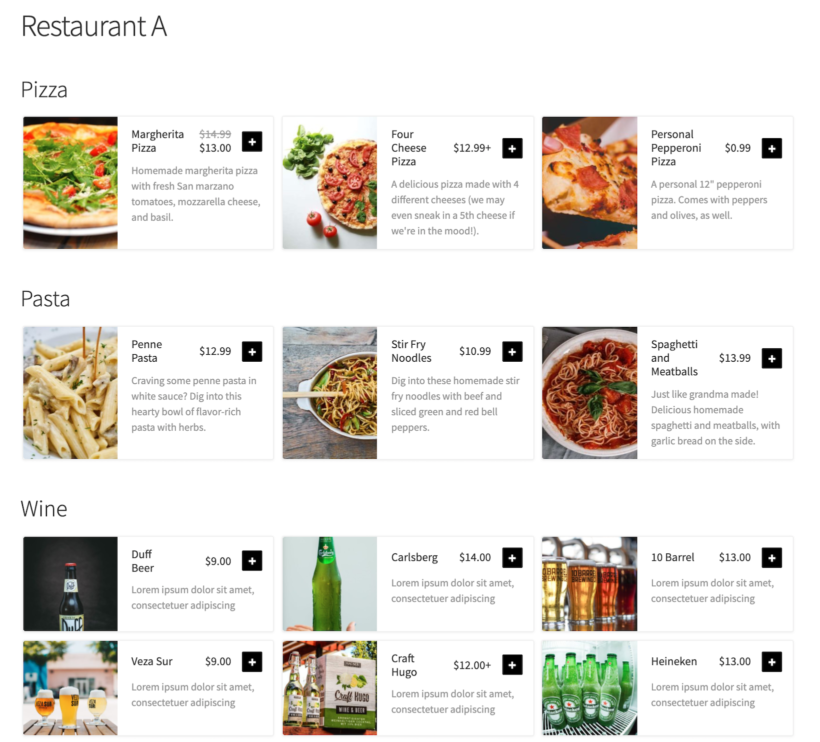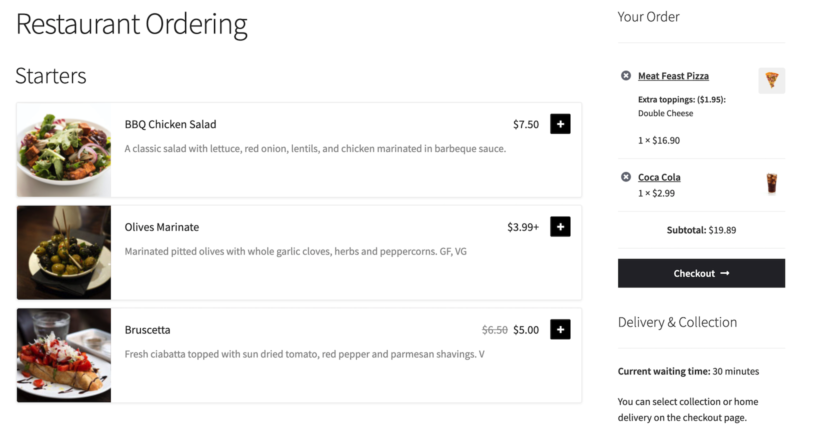Build a WordPress multi vendor food ordering system for restaurant delivery

If you run a restaurant that has multiple locations like Chipotle or McDonald’s then you might want need a multi vendor food ordering system on your WordPress website. This way, you can take food delivery orders online and deliver to customers from the closest restaurant vendor.
The question is: what is the best way to set up a WordPress or WooCommerce multi restaurant ordering system?
In this article, we’ll walk you through three different ways to create a WordPress multi vendor food ordering system. Each option is powered by WooCommerce and the WooCommerce Restaurant Ordering plugin. You can choose which method to implement based on how you need the food delivery for multiple restaurants to work.
Can I run a multi restaurant ordering system on a single WordPress website?
The first thing you need to decide is whether to have a single website for all the restaurants in the chain, or a separate website for each vendor.
Put simply, if you have multiple restaurants - e.g. a multi restaurant chain like Chipotle or McDonald's - then each one needs an order online system. But you can achieve this with one website or multiple websites.
Either way, the goal is to keep track of which restaurant branch the order was made to. This way, you can have the online food order sent to the correct location for delivery.
The easiest way to create a multi vendor food ordering system in WordPress is to keep everything on one website. Here’s why:
- Less management. Setting up multiple restaurant websites means more management work. You’ll have to purchase separate domain names, buy hosting, and keep your websites up to date.
- Cost-effective. Having a single website for your multi restaurant online ordering system is much more cost-effective than managing multiple websites. You’ll save on hosting costs as well as the technologies you’ll need to use to power your multi restaurant website and keep it up to date.
- Easier to keep track of orders. Instead of implementing a complex system that keeps track of which website the order was placed through, you can use a simple restaurant ordering system to manage multi restaurant orders through one website.
So, for most restaurateurs, having one website for their multi vendor food delivery system is better than setting up multiple websites.
3 ways to create a WooCommerce multi vendor food ordering system

There are three easy ways to create a multi vendor food delivery system in WordPress. They all use the WooCommerce Restaurant Ordering plugin, which makes it easy to take food orders online. The difference is how you structure your store to support multi restaurants.
Method #1 – Set up WordPress multisite
A WordPress multisite lets you manage multiple websites on a single WordPress installation. This is perfect for anyone who wants to keep their food ordering system for each restaurant completely separate, while managing everything as a single website behind the scenes. It also makes it easy to offer different opening hours or food delivery slots for each restaurant.
Method #2 – Create one website with an ordering page for each restaurant
You can create separate categories for each restaurant on a single WordPress website. You can then create an online order page for each restaurant by listing the food items from each of their categories. Although you can’t prevent customers from placing orders from more than one restaurant at once, you can use clear navigation and customer information to discourage this from happening.
Method #3 – Use a multi vendor plugin to allow multiple restaurants to register and add products
If you want to allow each restaurant’s manager to manage their foods, food menus, and orders separately then you can use a WordPress multi vendor plugin. Each restaurant manager will have their own login credentials. Additionally, you won’t have to worry about setting up (or managing) a WordPress multisite.
Feel free to read through each method to decide which one is right for you, or click on the jump links above to skip to a specific method.
Method #1: Set up WordPress multisite
For those unfamiliar, you can use WP multisite to create a separate website for each one of your restaurants. In other words, you can have a multi restaurant online ordering system under a single WordPress installation. Each restaurant will have its own admin area where you can add products and view orders.

So, once you have your WordPress multisite set up, you can use the WooCommerce Restaurant Ordering plugin to accept restaurant chain orders online for takeout or contactless delivery. This way, you can keep everything separate while allowing each restaurant manager to add and manage their own food items, restaurant menus, and orders.
This method requires the most amount of work to set up and maintain compared to the other options. Additionally, your WooCommerce Restaurant Ordering plugin license will need to cover the correct number of sub-sites you intend on setting up. This is because each sub-site counts towards your license activation.
How to set up WordPress multisite
- First, set up a WordPress multisite with one sub-site for each restaurant. If you’re not sure how to set this up, check out this guide for step-by-step instructions. If you already have a WordPress website, then you can simply enable multisite on it.
- Go to the network admin for your multisite, install and network-activate these two plugins:
- Now follow these steps for each sub-site/restaurant:
- Use the WooCommerce setup wizard to configure the restaurant order system. This will walk you through important steps like enabling payment gateways, tax and choosing your currency.
- Go to Products → Categories and add all the food categories from that restaurant's menu.
- Go to Products → Add New and add each food item.
Finally, go to the Pages list in the WordPress admin area for each sub-site/restaurant. You will find a 'Restaurant Ordering' page which automatically lists all the food products for that restaurant, divided by category. (Rename this to anything you like.) Customers can place their orders and proceed to the checkout page to arrange food delivery.
Delivery and collection
The settings for each sub-site are managed separately, so it's easy to add delivery and collection options for each restaurant individually.
What about order notifications?
For order notifications, you can enter the restaurant's email address on each sub-site. The new order emails will automatically be sent to the correct address for that location.
If you decide to use additional plugins to send SMS order notifications or print orders directly to the kitchen, then these can also be set up per sub-site. You can enter the correct mobile number or printer details for each restaurant location without needing to worry that customer orders will be sent to the wrong location.
Method #2: Create one website with an ordering page for each restaurant
The simplest way to set up a WooCommerce multi vendor food ordering system is by creating one WordPress website, with an ordering page for each restaurant. The key benefit of this approach is that it’s incredibly easy to set up and maintain over time.

Plus, you can use a single site license of the WooCommerce Restaurant Ordering plugin to power your restaurant ordering system.
The drawbacks of this method are:
- You can’t prevent people from ordering from one restaurant at once. The workaround is to make your restaurant website’s navigation super clear.
- It's slightly tricker to keep the orders and notifications for each website separate. We provide advice on how to do this below.
How to add a food ordering page for each restaurant
Once you've got a WordPress website set up with the free WooCommerce plugin installed, the first step is to create product categories for each restaurant. You can do this by heading over to Products → Categories from the WordPress admin panel. For example, you could create categories Restaurant A, Restaurant B, and Restaurant C. Then, each category would have sub-categories like Pizza, Pasta, and Wine.

Next, create a new page for each restaurant (Pages → Add New). Use the WooCommerce Restaurant Ordering shortcode to list the food products from each of the restaurant's categories, for example [restaurant_ordering category="starters"]. Each shortcode will insert a food order form listing the correct products.
Repeat this step to create a food ordering page for each vendor in the multi restaurant delivery system.
Delivery and collection
Since you will have one WordPress website for the entire multi restaurant ordering system, the delivery and collection options are managed centrally.
If you want to offer different delivery/collection options or times for each restaurant then you can do this using the WooCommerce Opening Hours & Chosen Times plugin. This has a feature which lets you enable different delivery/collection options and set different time slots per category. Since each restaurant has its own category, this allows you to manage the delivery and collection option for each location individually.
Alternatively, the Conditional Shipping and Payments plugin lets you show different shipping and payment options for each restaurant.
What about order notifications?
WooCommerce sends order notification emails to one email address for the entire website. That means that the email is sent to the same place regardless of which restaurant the order relates to. This isn't suitable for most multi restaurant food ordering systems, so you'll need an extra plugin.
The WooCommerce Multiple Email Recipients plugin lets you send new orders to a different email address for each product category. So, for example, when a restaurant receives an order, you can automatically route the customer’s order information directly to the correct restaurant.
Method #3: Use a multivendor plugin to allow food vendors to register and add products
A WordPress multi vendor website gives each restaurant’s manager complete control over the food items, restaurant menus, and orders. Food vendors can register, upload food products, and manage their orders from a single WordPress site.

The best part is that the WooCommerce Restaurant Ordering plugin works with all popular WordPress multivendor plugins including:
- YITH WooCommerce Multi Vendor
- WooCommerce Product Vendors
- Dokan Multi-vendor Marketplace
- MultiVendorX
How to set up a WordPress multi vendor plugin for multiple restaurants or groups
- First, set up your chosen multi vendor plugin and install WooCommerce Restaurant Ordering. Tick the 'Category pages' box on the settings page.
- Create product categories for each vendor by going to Products → Categories. The different categories could be Vendor A, Vendor B, and Vendor C. Then, each category would have sub-categories like Starters, Main Courses, Desserts, and Drinks for each restaurant’s food items.
- Behind the scenes, the multi vendor plugin has created a main shop page for each restaurant. You only need the vendor's category pages, so use the free Redirection WordPress plugin to automatically direct each vendor’s shop pages to their main category page.
Check out our complete guide on how to create a WooCommerce restaurant ordering system.
Delivery and collection
As with Method 2, the delivery and collection options are managed centrally. You can set different delivery/collection options or times for each restaurant by installing the WooCommerce Opening Hours & Chosen Times plugin. Its category-level control lets you set different options and time slots per restaurant.
You could also use the Conditional Shipping and Payments plugin to offer different shipping and payment options per category.
What about order notifications?
The WooCommerce multi vendor plugin will automatically email new order notifications to each restaurant. You can use this alongside extra plugins to notify restaurants of new orders in order ways, such as SMS order notifications or direct printing to the kitchen.
Where to get the plugin
WooCommerce Restaurant Ordering makes it easy to create a multi vendor food ordering system in WordPress. It's super-flexible and you can structure your multi restaurant food delivery website in the way that best suits your needs:
- WordPress multisite with sub-sites for each restaurant
- Create one website with an ordering page for each restaurant, or;
- Use a WordPress multivendor plugin to allow food vendors to register and add products
Ready to set up a multi restaurant online ordering system? Get WooCommerce Restaurant Ordering today.
6 Comments
Hi,
Could you please suggest a good multivendors restaurant marketplace theme?
Hi Mike, thanks for the comment. I'm afraid we don't have a specific recommendation for the theme for that use case. That said, we have a list of themes that we generally recommend and we know work well with our plugins. Please see - https://barn2.com/kb/supported-themes/. If you have further questions, you can also reach us through our Support Center. Cheers!
Hello, I already saw that your plugin is not compatible with WCFM Marketplace, but my question is if there is any way to use it? The plugin is WooCommerce Restaurant Ordering
Hi Eduardo. WCFM Marketplace – Best Multivendor Marketplace for WooCommerce, as it stands, is not included in the WooCommerce Restaurant Ordering list of compatible plugins. Hence, incompatibilities might be common and inevitable.
See: Compatible Plugins for WooCommerce Restaurant Ordering (barn2.com)
Having its own archive-product.php may potentially not allow us to extend its product catalog just like we normally would with a standard theme such as StoreFront. Nevertheless, I was able to test the two together on a test site and did not encounter any issues using them in tandem. But please keep in mind that since the plugin in question is not currently on our list of compatible plugins, issues may arise.
I hope this makes sense and helps. If you have any more questions, you can get in touch via our Support Center, and we would be delighted to discuss this with you in more detail. Many thanks!
Is this plugin compitable with wcfm multivendor marketplace plugin?
Hi, Akhter. WCFM has its own custom archive-product.php page template, which makes it a bit trickier to use with plugins like ours. However, you can still use it with either WooCommerce Restaurant Ordering or WooCommerce Product Table by creating categories for each vendor, and using the shortcode from our plugins to list products from a specific vendor's category. You would also want to install the free Redirection plugin and redirect the main page for each vendor to the page where you have added the shortcode - that way, customers won't be able to visit the default vendor page created by the multi-vendor plugin.
I hope this makes sense. We can discus this in our detail via email if you could send us an enquiry via our Support Center. Many thanks!